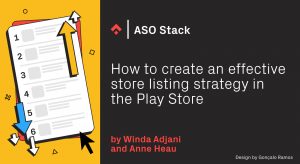
When developing an effective app growth strategy in the Play Store, marketers have two kinds of store listings at their disposal: main and custom store listings. Including both into a comprehensive store listing strategy will allow you to target and convert more users in a more effective way. In this article we’ll outline how to develop such a strategy.
What is the difference between main and custom store listing?
Main Store Listing (MSL) is Google Play’s standard store listing setup. It targets users based on their device language setting meaning that the MSL audience is worldwide. For example, the English (United States) MSL can be viewed by anyone in the world who has their phone set to US English. Because of this, we recommended you create generic textual and visual assets for this type of listing, in order to resonate with a broader audience.
You will have the option to select the default MSL for your app, and afterwards add additional localizations which you can then optimize. Users with a language device setting for which a localization is not available will view the default MSL.
Custom Store Listings (CSL) on the other hand allow developers to target users based on their country or app-install state, or (and most recently) by URL. This allows developers to localize with extreme precision as their audience is more specific. You can open up to 50 CSLs, and add multiple localizations (languages) for each CSL. To find out how custom store listing was affected by the latest Google update take a look at this article.
How do main store listings and custom store listings compare head-to-head?
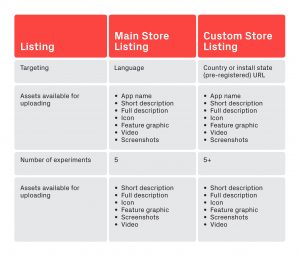
Localizing for your main store listing
Although your MSL reaches a global audience you are still able to localize your assets by adapting your MSL strategy viewer population. This means that by using the Google Play Console’s Conversion Analysis tab, you will be able to deep dive and break down where the highest percentage of your MSL viewers are located.
See how to find this information on the following image.
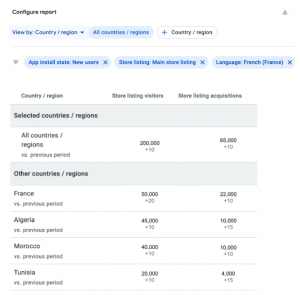
After checking, you’re likely to find yourself in one of two common situations:
- The majority of users are mainly located in one country. This often happens for languages that are less popular than English. For example, most of the people who speak Indonesian, live in Indonesia. In this case, for your id-ID MSL, you can localize your assets more precisely as you know a large percentage of your viewers are coming from one country, however, it is still important to have some generic elements for those users who are not a part of the majority.
- Your users are based across different countries. This will happen for very common languages such as English, Spanish, and French. In this case, it would be best to keep most of the assets generic, however, you can still add some splashes of localization here and there. For example, we found that a considerable percentage of viewers viewing our French MSL are from North African countries, therefore, we should try to localize our assets with this in mind.
Leveraging custom store listings
As you now know, CSL targets users based on their location. So, how can you use that information to your advantage?
- Create a CSL for countries where the national language has a lot of global speakers.
Around 1.5 billion people worldwide speak English with the most common divergents being North American and British English. However, not all English speakers share the same background, nationality or values – even within certain dialects.
For example, North American users will convert differently to users based in Singapore, who happen to have US English set as their device language. Therefore, it is important to separate these users. Having a US or Canadian CSL will allow you to reach your US English-speaking users in North America, using more localized creative and textual assets, while your US MSL targets your US English-speaking users worldwide.
2. Highlight country-specific features or promotions
Use your CSL as an opportunity to highlight features or promotions that are specific to a country. Heetch, a French ride-sharing app, highlights the streets of France in their French CSL, and streets of Belgium in their BelgianCSL. Not only is this a great way to personalize the user journey but we can also see that in France it only takes 2 minutes to get a driver, as opposed to3 minutes in Belgium. By using CSL to highlight this difference, Heetch has ensured the user’s expectations have been managed. In the process Heetch has minimized the potential for negative brand image, ratings, and reviews and through a localized picture, may even boost conversion.

3. Targeting countries where there are multiple languages.
India is the perfect example of a nation with multiple official and unofficial languages.. It has speakers of US English, British English, Indian English, Hindi, and many other dialects. This makes targeting all of them effectively and through just one MSL impossible. Opening a CSL for locales such as this will allow you to target a majority of the online population through just one listing. In the following example, we see a custom store listing optimized for the English-speaking population in India.
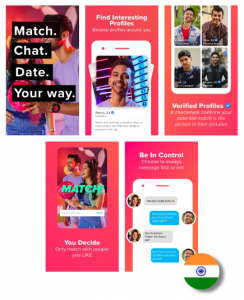
4. Increasing A/B testing velocity.
Apart from targeting your audience more effectively, you can also use custom store listings to increase the number of available store listing experiments you can run simultaneously. This means you can run A/B tests for localizations in your CSL in addition to the five you can run via MSL. This makes a total of 5+ store listing experiments. By allocating CSL spaces to ‘slower’ locales (possibly with a lower amount of visitors) that take longer to gather testing results, you can have your 5 MSL testing spaces open for ‘faster’ locales that will always be open and on rotation.
5. Targeting speakers of one language across different countries.
As opposed to the first suggestion we shared on how to leverage your custom store listing to target the population of one specific country, you can also use it to target populations speaking the same language across different countries. For example, the DACH region consists of German speakers from Germany, Austria and Switzerland. Grouping them together through one DACH CSL will allow you to optimize for these countries at the same time.
Developing your store listing strategy
Now that we’ve covered the basics of MSL and CSL as well as some use cases, we can move on to how you can actually develop your store listing strategy, and answer the question of which locales should be an MSL and which should be a CSL?
For this, you should take a look at the following metrics:
- Store Listing Visitors and Installers. By taking a look at your visitors and installers by language and country, you should get a good understanding of your market size. Using this as a starting point, you can decide which locales to focus on.
- Store Listing conversion rate. Is there room to improve your conversion through creating an additional store listing?
- Revenue. Is the locale you’re focusing on bringing in enough revenue? Optimizing for an additional store listing takes additional time and resources. Make sure that it is worth it before you commit.
- What languages are spoken in the country? Here you are focusing on the country. To determine if it would be worth creating a CSL for a specific country, you should first check what languages are spoken in that country. If there are a lot of languages spoken, it means that it would be more difficult for you to target users through just one MSL, and therefore creating a CSL makes sense. If that’s not the case, then it’s probably enough to have this locale as an MSL.

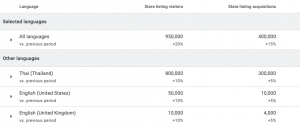
- Language speakers grouped in one country vs. language speakers spread across multiple countries – Here you are focusing on the language. If the majority of the people who speak this language are located in one country (see our Indonesia example from before), it is probably not worth creating a CSL. However, if the speakers of this language are located in a few different countries (English or Spanish, for example), it would be worth creating a CSL to specifically target multiple countries.
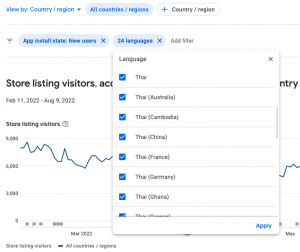

In the images above, we have used Thailand as an example. Here we can see two things. The first thing is that the majority of people in Thailand have Thai set as their device language. Secondly, that the majority of Thai speakers (worldwide) are located in Thailand. Because of this, it makes sense to have Thailand as an MSL.
There are lots of options you could explore by incorporating custom store listings into your usual store listing strategy, which will give you better chances of increasing conversion. At Phiture, we are currently testing more ways to effectively use the additional CSLs (50 after Google’s latest update) as a part of an advanced app growth strategy. Stay tuned to find out more about this in our future posts.
Before You Go
- To find out how custom store listing was affected by the latest Google update take a look at this article.
- Please make use of our Slack Stack channel to ask us any other questions and we’d love to answer them where we can.
- If you’re looking for more insights into how to approach localization in different markets, our guide to localizing for Arabic-speaking markets is instructive in the thought process that should underpin specialized localization.
- If you need specific ASO advice, you can reach out to us on ASO Stack and one of the Phiture team will be in touch!












